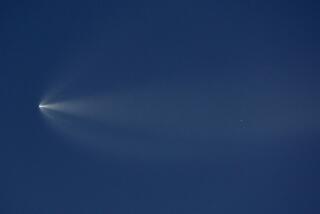SpaceX failure tests its bold agenda

Before its unmanned rocket disintegrated Sunday, SpaceX had become an industry rising star. The brainchild of billionaire Elon Musk was not just blasting spacecraft into orbit, but was making it look easy.
Companies across the world had signed up to have SpaceX launch their satellites, won over by the firm’s reliability — 18 consecutive successful flights — as well as its attractive price of about $60 million for a commercial launch.
But at the company’s Hawthorne headquarters, employees were already struggling to keep up with its aggressive schedule of almost 50 upcoming launches.
And with the spectacular failure of Sunday’s cargo mission to the International Space Station, the firm’s efforts to fulfill those launch orders, now worth $7 billion, are coming to an abrupt halt.
Over the last year, the firm has repeatedly pushed back its ambitious schedule.
“They certainly have not been able to keep up,” said Roger Rusch, the president of TelAstra, a South Bay satellite industry consulting firm, pointing to the frequent delays in the company’s launch lineup.
Rusch said that as SpaceX continues its investigation into the failure, it will have to satisfy not just NASA that its rocket is safe but also its many commercial customers and the Pentagon.
He estimates that SpaceX will stay grounded for six months, causing frustrations for customers, some that may go elsewhere.
The first public delay since the accident came Tuesday when SpaceX postponed its next launch, which was set for Aug. 8.
The government weather satellite, known as the Jason-3, was already on its way to the firm’s launch pad at Vandenberg Air Force base in northern Santa Barbara County.
In a statement Tuesday, SpaceX tried to minimize concerns of a significant delay.
“We are working with our partners to prepare for potential delays on the order of a few months,” SpaceX said. “Once the root cause is identified, we will be able to better determine any changes to future launch dates, including Jason-3.”
At least one customer, Iridium Communications, which has ordered seven launches from SpaceX,
said Tuesday that it’s faith in the firm had not wavered.
Diane Hockenberry, a spokeswoman for Iridium, said executives were confident SpaceX will “successfully bring our satellites to orbit.”
Others were skeptical of the company’s reliability even before the Falcon 9 rocket — carrying two tons of food, water and other
provisions — broke apart in the skies off Florida’s coast, leaving a cloud of debris.
In the weeks before the failure, Pentagon officials had argued that they could not solely count on SpaceX as they lobbied Congress to ease a ban on Russian rocket engines.
The engines are used in a rocket flown by a joint venture of Boeing and Lockheed — which has launched more than 90 spacecraft for the military without a failure.
Last year, three congressional members from Alabama and Colorado — where the Boeing-Lockheed venture has its operations — asked NASA for information about SpaceX launches that they said involved “an epidemic of anomalies.”
The problems cited in the members’ letter ranged from “multiple” helium leaks in the Falcon 9 rocket to seawater seeping into the company’s Dragon capsule after splashdown.
Sunday’s failure gives more ammunition to the company’s critics, especially those in Congress who support the Boeing-Lockheed venture known as United Launch Alliance.
Before Sunday, SpaceX’s long string of successes had put the joint venture, run by the two of the world’s biggest military contractors, on the defensive.
The venture had begun to cut staff and streamline operations in an attempt to lower its high prices to compete with the upstart.
Last year, government auditors calculated that the joint venture was charging the Pentagon more than $400 million for each launch — work SpaceX has said it could do for a quarter of the price.
SpaceX keeps costs low by manufacturing its own engines, rockets and capsules at its factory in Hawthorne.
Rusch, the satellite industry analyst, said costs also decline as the SpaceX launches more rockets, keeping its teams constantly busy.
“If you can launch fast,” Rusch said, “you can lower the cost.”
Manufacturing its own equipment may also help SpaceX more quickly pinpoint what went wrong than if it depended on myriad subcontractors, said SpaceX President Gwynne Shotwell.
At a news conference Sunday, she said the company is in an “extraordinary position” to identify the problem and fix it, since the company owns all of the rocket’s components.
The company is now reviewing reams of data to determine why the cargo ship fell apart when it was 28 miles high.
Soon after the rocket disintegrated, Musk tweeted that “there was an overpressure event in the upper stage liquid oxygen tank.”
He later said the company’s engineers were “parsing data” to recover the “final milliseconds” of the flight.
“Cause still unknown after several thousand engineering-hours of review,” Musk wrote.
One person seemed delighted by the rocket’s demise.
With the grounding of SpaceX, NASA is now reliant on the Russians to haul critical supplies to the space station. A cargo-carrying Soyuz rocket is scheduled to blast off to the space station Friday.
Tweeted Russian Deputy Prime Minister Dmitry Rogozin, who is in charge of the country’s defense program: “After the fall of Falcon rocket, the only hope is ‘Soyuz.’”
Twitter: @melodypetersen







